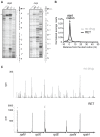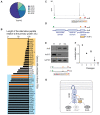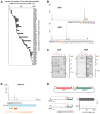Retapamulin-Assisted Ribosome Profiling Reveals the Alternative Bacterial Proteome
- PMID: 30904393
- PMCID: PMC7115971
- DOI: 10.1016/j.molcel.2019.02.017
Retapamulin-Assisted Ribosome Profiling Reveals the Alternative Bacterial Proteome
Abstract
The use of alternative translation initiation sites enables production of more than one protein from a single gene, thereby expanding the cellular proteome. Although several such examples have been serendipitously found in bacteria, genome-wide mapping of alternative translation start sites has been unattainable. We found that the antibiotic retapamulin specifically arrests initiating ribosomes at start codons of the genes. Retapamulin-enhanced Ribo-seq analysis (Ribo-RET) not only allowed mapping of conventional initiation sites at the beginning of the genes, but strikingly, it also revealed putative internal start sites in a number of Escherichia coli genes. Experiments demonstrated that the internal start codons can be recognized by the ribosomes and direct translation initiation in vitro and in vivo. Proteins, whose synthesis is initiated at internal in-frame and out-of-frame start sites, can be functionally important and contribute to the "alternative" bacterial proteome. The internal start sites may also play regulatory roles in gene expression.
Keywords: alternative initiation; arcB; internal genes; retapamulin; ribosome profiling; rpn; speA; translation initiation.
Copyright © 2019 Elsevier Inc. All rights reserved.
Conflict of interest statement
The authors declare no competing interests.
Figures





References
-
- Alvarez AF, Barba-Ostria C, Silva-Jimenez H, Georgellis D. Organization and mode of action of two component system signaling circuits from the various kingdoms of life. Environ Microbiol. 2016;18:3210–3226. - PubMed
-
- Alvarez AF, Georgellis D. In vitro and in vivo analysis of the ArcB/A redox signaling pathway. Methods Enzymol. 2010;471:205–228. - PubMed
Publication types
MeSH terms
Substances
Grants and funding
LinkOut - more resources
Full Text Sources
Other Literature Sources
Molecular Biology Databases

